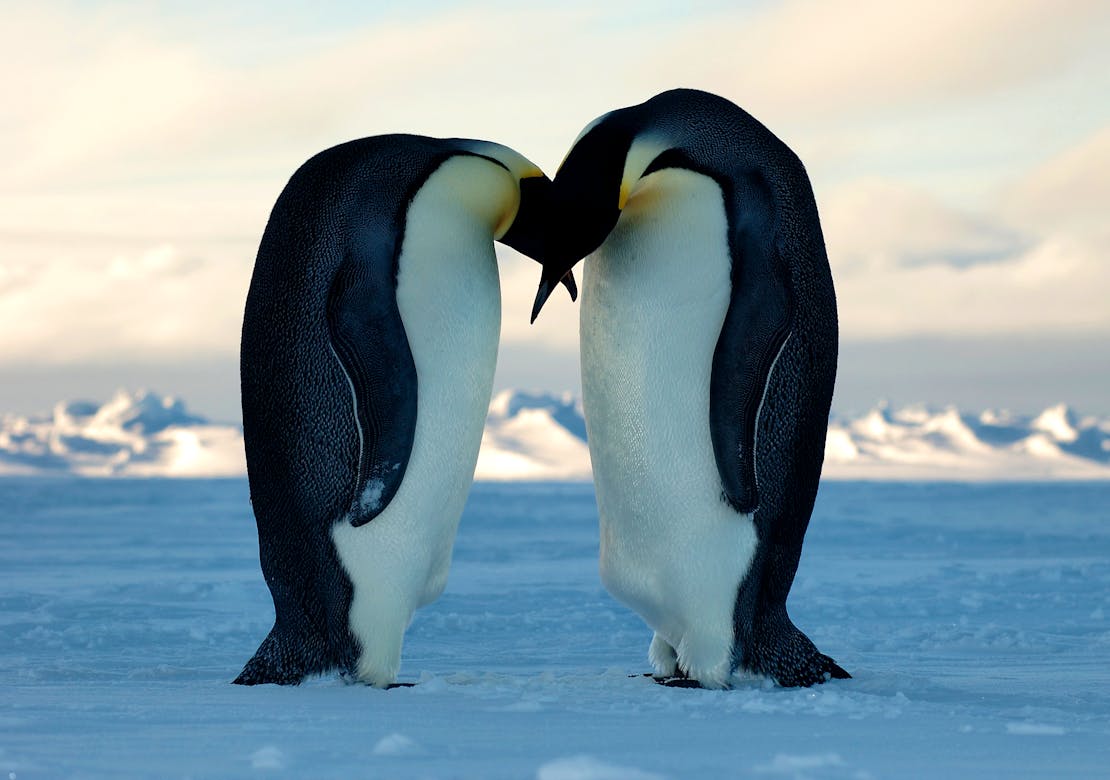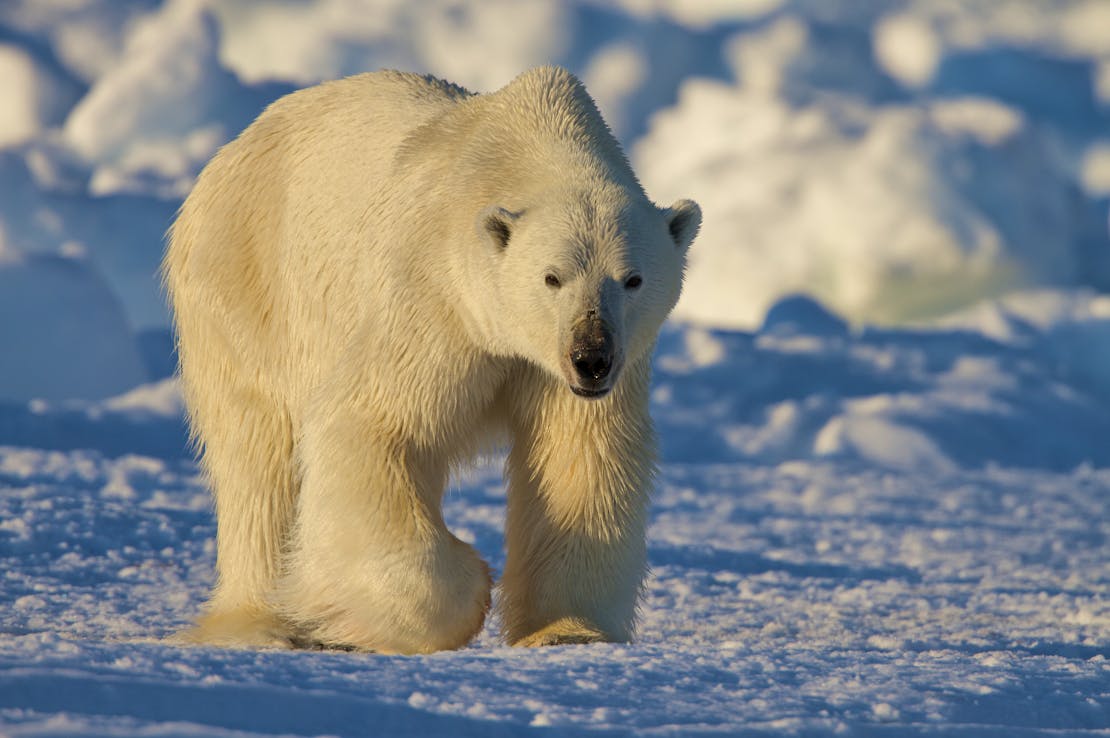The U.S. Fish and Wildlife Service (FWS) has officially declared the emperor penguin a threatened species under the U.S. Endangered Species Act (ESA) due to the existential risk posed by climate change. This listing exemplifies the growing threat of climate change and the need for strong action to help combat it and the other major drivers of biodiversity loss.
As a key indicator species, changes in the emperor penguin population can be indicative of the health of the Antarctic marine ecosystem and the overall growing impact of climate change. While currently, the population appears to be stable, researchers say as many as half of these Antarctic birds could be lost by 2050. The main danger is sea ice loss, which reduces the space they need to breed and raise chicks. Parts of the Antarctic Peninsula’s sea ice have melted by more than 60% in 30 years and predictions suggest continued loss in the coming decades.
The polar bear, a species that Defenders has invested a lot of time protecting, was the first species listed by FWS in 2008 as threatened due to the threat of climate change. Today, the agencies consider climate change as a threat to many more listed species. However, there are no wild emperor penguins living in U.S. territory, meaning that action will need to take place on the global stage. With this listing, the U.S. demonstrates their willingness to take a leadership role in tackling the interconnected biodiversity and climate crises. Ideally, next steps will help push forward international conservation measures for the species, help reduce industrial fishing that diminishes the penguins’ food source and require American producers of greenhouse gases (which are causing the melting of polar ice) to reevaluate their carbon footprints. Importantly, a strong tool for conserving species threatened by climate change like the ESA can guide U.S. efforts to mitigate anthropogenic climate change.
Through the Endangered Species Act, the U.S. is employing one of the world’s most powerful laws for wildlife conservation. To date, over 95% of the species listed under the act have survived the threat of extinction and hundreds are on the path to recovery. In fact, more than 50 species have been removed from the list because the agencies have determined they have recovered to the point where they no longer need the protections of the ESA. Listing the emperor penguin as threatened under the Endangered Species Act gives the species access to protections under the ESA.
However, the ESA faces major challenges that weaken its ability to prevent extinction, recover imperiled species and protect the ecosystems in which they live. For one, the ESA is starved for resources, with the FWS receiving only half of the funds needed to effectively operationalize the ESA. Additionally, the protections of the ESA weakened by previous administrations have yet to be fully restored. While Defenders of Wildlife advocates for the strong, fully-funded ESA that Congress intended when it passed the Act, it still offers a potentially powerful tool to protect species impacted by climate change.
Given that they spend most of their lives on ice, penguins and polar bears are some of the most obvious species to be granted ESA protections due to the threat of climate change. But there are numerous other species that will suffer the consequences of a warming planet, and likely go extinct, if humans do not dramatically change course and reduce their greenhouse gas emissions.
Pinyon Jay
In April, Defenders of Wildlife petitioned FWS to protect the pinyon jay under the ESA. The bird is experiencing a precipitous decline throughout the western U.S. due, in part, to the loss and degradation of its pinyon-juniper woodlands habitat. Climate change has exacerbated this loss, resulting in significant mortality of the pinyon pine. In the last 50 years, the pinyon jay population declined by 85%, and, without the protections afforded by the ESA, half of its remaining global population is expected to be lost by 2035.
The pinyon jay serves a critical role in the Southwest, facilitating pinyon pine tree regeneration by eating and burying their seeds, commonly known as “pine nuts.” Without pinyon jays, it's not clear that the pinyon pine tree would survive, or vice versa. Loss of pinyon pine not only impacts the pinyon jay, but it would disproportionately affect Native American and Hispanic communities in the Southwest, which have a cultural and traditional connection with pine nuts as a food source. For generations, Native Americans in the Southwest have harvested and consumed the seeds. During the fall harvest, families collect these nutritious seeds and store them for the winter. This important cultural tradition would likely be lost if the pinyon jay went extinct.
Corals
Corals are marine invertebrates related to sea anemones that serve as ecosystem engineers, building elaborate structures that make up coral reefs—the most diverse of all marine ecosystems. Staghorn coral (Acropora cervicornis) is just one example of the listed coral species experiencing disastrous declines due to climate change. Rising sea temperatures and mass bleaching incidents have killed coral around the world. Additionally, increased carbon dioxide absorbed into the ocean from the atmosphere has already begun to reduce reef-building as a result of ocean acidification. Global coverage of living coral has declined by half since the 1950s, as has their capacity to provide important ecosystem services.
Staghorn coral in particular has been one of the three most important Caribbean corals in terms of its contribution to reef growth and fish habitat, but its populations have been declining by up to 98% in some parts of its range.
Red Knot and Other Shorebirds
While shorebirds may be listed due to multiple threats, including habitat degradation or exploitation, climate change remains a consistent threat that can hasten their extinction. Coastal sea rise limits shoreline habitat for nesting, breeding and raising young, and stronger, more frequent storms can contribute to detrimental flooding of habitat. Rising sand temperatures can also impact nesting behavior in some species.
The threatened red knot has one of the longest migrations of any bird, traveling from the Arctic to the southern tip of South America. Researchers note lower reproductive success and survival rates in Arctic breeding grounds during warmer years. Climate change also impacts the current and future quality and quantity of prey resources throughout the species’ range, contributing to malnutrition of chicks—a dangerous state for a bird that needs lots of energy for the long flight ahead. Red knot populations have declined 87% since 2000, and more than 94% since the 1980s in some areas of the Atlantic Coast.
The U.S. has important historical standing as a global leader in environmental protection and the emperor penguin listing may open additional opportunities to lead on biodiversity conservation. A listing under the ESA can encourage international cooperation for addressing climate impacts on our world’s wildlife, but effectively protecting this species and recovering the many others listed will require a strong ESA. It will also require a government willing to fulfill Congress’ mandate set forth in the ESA—to safeguard our precious natural heritage by protecting and recover species threatened with extinction.
Check out our Field Guide to Climate Change to learn more about specific species that are in danger of going extinct due to climate change and what Defenders is doing about it.













